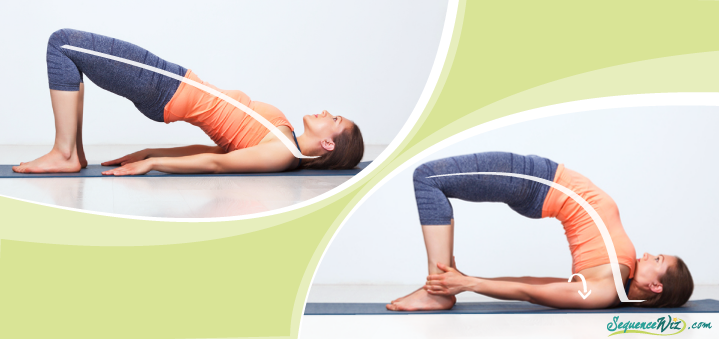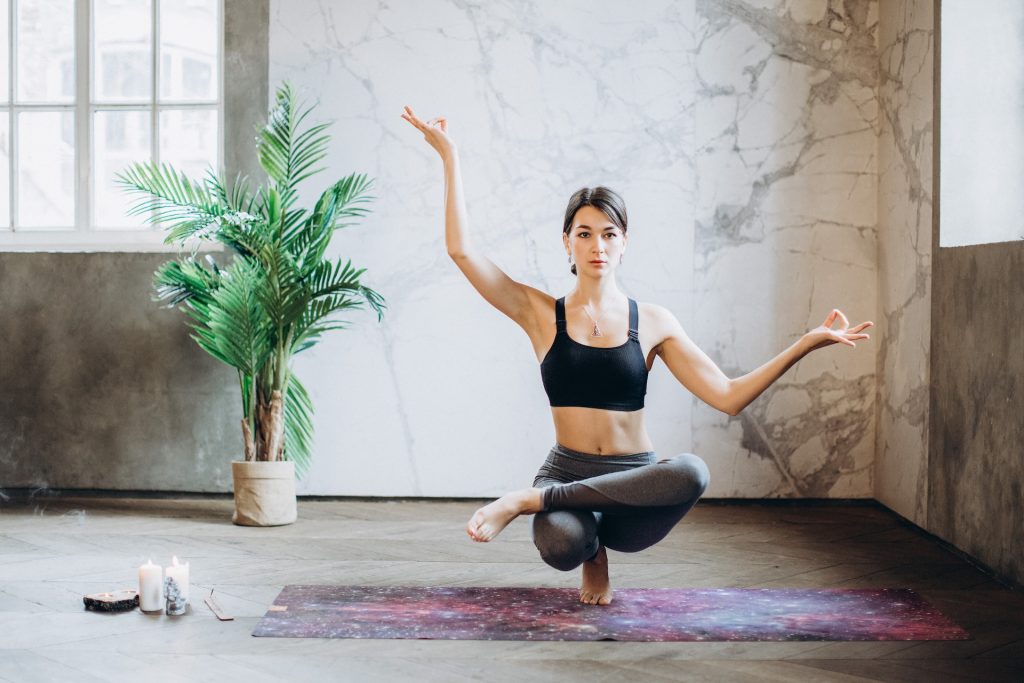If you’re just starting to learn yoga, don’t worry – there are plenty of easy yoga poses perfect for beginners. These simple poses can help reduce anxiety and relax the mind while improving physical fitness. In this guide, we will detail 9 easy yoga poses that new practitioners can start with, giving you all the information you need to know to get started.
Read Also: What Are The Benefits Of Yoga? 5 Best Books With Yoga Advice
9 Easy Yoga Poses To Help You Get Into Full Splits
1. Chakrasana: Easy yoga poses for beginners
Wheel Pose, also known as Chakrasana in Sanskrit, is an intermediate-level yoga pose with a shape that resembles a wheel. It involves the full arc of the body and encourages deep spinal flexibility. To achieve this pose, begin on your back with your feet hip-width distance apart. Gently raise your hips up until you are supporting your torso weight with your arms straightened out in front of you and the crown of the head resting firmly on the ground. Finally, slowly lift both feet off the ground and tuck your shoulders and forearms beneath your lifted torso for support.
Here are the core benefits of Chakrasana:
- Chakrasana strengthens the liver and pancreas
- Good for Infertility, Asthma
- Wheel Pose Strengthens arms, shoulders, hands, and wrists.
- Stretches the chest and lungs
- Stimulates the thyroid and pituitary glands.
- Increases energy and neutralizes
2. Half-Split Pose
From a standing position, the front and rear legs move away from each other and the inner thighs come together. Drop the back knee onto the mat and the top foot flat. The spine lengthens when the upper body is bent over the front legs and the palms are on the floor. Keep the front leg straight.
This pose is a great starting point to prepare for splits. Low Lunge is an exercise that opens the hips, strengthens the legs, is useful for sciatica, and massages the digestive and reproductive organs. Posture can help with elimination, thus literally helping us to get rid of what is no longer serving us.
Here are the core benefits of Half Split Pose :
Stretches the spine, hips, and hamstrings. Strengthen your legs. Stimulates abdominal organs.
Always talk to your healthcare provider before starting any health plan. By accepting and following these guidelines, you do so at your own risk. cannot be held responsible. So we have to accept them by doing this Yogasana.
3. Reclined Pigeon Pose: Easy Yoga poses
This variation is common in Restore: Restorative Yoga and Sound Yoga classes. If you also want to work out this way, hold the stretch longer. Both styles mentioned holding movements for at least 15 breaths or at least 3 minutes.
To perform this variation, lie on your back near a wall. Bend your knees and place your feet on the wall. As in the classic version, cross the right ankle over the left knee and keep the foot bent.
Press your left foot into the wall and place your hands behind your left knee. You can also put your bracelet by your side. Slowly move your left foot down the wall to deepen the stretch. As soon as you feel a comfortable stretch, pause and hold this pose for as long as you like. Release and repeat on the other side.
If you want to do this Reclined Pigeon Pose, you must be prepared in advance. And if you rush to do this without prior preparation then you may face physical problems.
4. Happy Baby: Simple yoga
Start lying on your back, body straight and relaxed, then bring your knees toward your chest. Extend both arms between your bent legs and catch both big toes in a ‘toe lock’. The shoulder blades and the entire length of the spine should support the floor.
Your head should be on the floor, your back flat, and your ankles flat on your knees so that both shins are perpendicular to the mat under you. Extend your legs and let your thighs drop along your torso, legs bent at a 90-degree angle.
Pull your knees to the floor with the help of your hands, while pushing your heels into the air, feeling the deep stretch in your hips, groin, and thighs. Stay here for a minute or two, add some rocking if you like. But you will ensure our child does not get hurt in any way.
Here are the core benefits of Happy Baby:
- Open inner thighs, hips, and groin
- lower back pain relief
- rearrange and lengthen the spine
- reduce stress and anxiety
- improve fatigue and lethargy. hamstring stretch
- heart rate reduction.
5. Lizard Lunge:
To be able to do yoga, you must be able to put your knees behind your arms when you are in a sitting position.
In Lizard Lunge, you can see if your shoulders are below your knees. In this position, the back leg is straight and the front leg is bent with the shin perpendicular to the floor.
If you can easily place both forearms evenly on the floor, chances are you can do Astavakrasana with flexibility. Initially, you start with your hands on the floor. It is essential to lower them evenly. You may need to back up until this is achieved. This process may take some time. If you are interested in Astavakrasana, you may want to practice Lizard Lunge every day until you can easily rest your elbows on the ground.
This practice can also unlock other poses for you, such as Warrior I, Pigeon, and Split. You can see my back knee lying on the ground in some pictures. You may need to bend your hind legs at first. Finally, you can keep your knees high and your hind legs straight.
Here are the core benefits of Lizard Lunge:
- Open hips, hamstrings, groin, and hip flexors.
- Strengthen the inner thigh muscles in the front leg.
- Open and release the chest, shoulders, and neck.
- Prepare your body for deeper hip openings such as Pigeon Pose and Hanuman Pose.
6: Uttanasana:
This pose is not recommended for people with back problems without the guidance of an experienced yoga teacher. Also, for people with tight hamstrings, Uttanasana may be contraindicated because if done incorrectly, the pose puts pressure on the lower back.
Tight hamstrings prevent the pelvis from moving forward freely and so the backward bend puts pressure on the discs in the lumbar spine. To avoid this, follow the remedies below or start with gentle hamstring stretches without weights, such as Supta Padagustasana.
Uttanasana offers many benefits:
it stretches the hamstrings and calf muscles, opens the hips and groin, stimulates the digestive system, and improves the functioning of internal organs, including the liver and kidneys.
Since Uttanasana gently stretches the large muscles of the legs, where many people hold tension, Uttanasana has a deeply relaxing effect. It calms the entire nervous system and relieves stress, anxiety, and insomnia.
So we will tell you again not to do this without your prior preparation.
7. Anjaneyasana:
You have to do these easy yoga asanas. Now slowly lower your left knee and place it on the floor or floor just behind the hip. Inhale and raise your torso; then raise the arms above the head, so that the biceps touch the ears, combine the palms and perform the Namaskar movement. Expired.
Allow your hips to relax and move forward, making it clear that you feel the front area of your leg and thus the hip flexor stretch. Hold your tailbone down. Stretch your lower back as you interact with your spine. Stretch your arms back so your core is pushed up.
Look back as you progress through difficult acrobatics. Hold the pose for 15 to 30 seconds. You can also lift your knee or back leg off the floor to do a full crescent. To release the pose, keep your hands on the ground and step back to Adho Mukha Svanasana.
Here are the core benefits of Anjaneyasana:
Stretch your hips over your back leg. Open the hip flexors and strengthen the hip extensors. Stretch the psoas muscle. Expand your shoulders and chest. Strengthens quads, glutes, and hamstrings. Strengthen the muscles that support the knee.
8. Half splits:

Half-divided pose, or Ardha hanuman asana in Sanskrit, is an easy yoga pose that prepares for the full expression of hanumanasana. From a low crouch position, the meditator places the back knee on the floor and straightens the front leg.
Start in a low squat with your right foot forward and your left foot back. Shift your weight back so that your pelvis is above your left knee, your right leg is straight out in front of you, and step your arms toward your body, or your right foot is slightly forward.
Lift the right toes off the ground, place the weight of the foot on the right heel, and keep the right knee slightly bent, the back should be straight, not round, and the neck in line with the spine. Once you have good alignment, hold the pose for at least five deep breaths
Here are the core benefits of Half Splits :
Half Splits The pose stretches the thighs, hamstrings, and groin, and does a great job of preparing for the full expression of the splits. This pose is also commonly referred to as Runner`s Lunge, and it’s understandable why – the benefits of stretching are especially beneficial for runners, who tend to maintain tension in their legs. surname.
So we all have to do it at least once a day making a half-split. As these are very important in our daily life. This yoga practice brings a lot of joy to our minds. that we have every day helps us to stay healthy.
9. Bridge pose: Easy yoga poses

To perform this yoga asana, you must first come and lie on your back on the mat and bend your knees, bringing your feet to the ground and heels a few inches in front of your buttocks. Your knees should be in line with your ankles and feet parallel, hip distance apart.
Place your arms at your sides and feel your fingertips to see that you can just brush your heels. Using your legs, press through your heels while slowly lifting your pelvis and hips off the floor, one vertebra at a time. Raise until your thighs are almost parallel to the floor and reach the tailbone to avoid any cracks in the lumbar spine.
Keep your arms at your sides or roll your shoulders under your back until you can squeeze your fingers in the yoga hand pose. This will create an extra gap in the chest.
Read Also:
15 Standing Yoga Poses To Improve Full-Body Balance & Stability
Here are the core benefits of the Bridge pose :
The bridge pose stretches the chest, neck, and spine and strengthens the legs. It is said to aid digestion, calm the brain, and relieve stress. This pose can also be modified into a restorative version using a block below the sacrum for support. Open chest muscles, muscles, and hips.
Soothes the body and relieves stress and mild depression. Stimulates organs in the abdomen, lungs, and thyroid gland. Rejuvenate tired feet. Improve digestion. If you do this yoga, you will surely get the benefits for your body.
.

